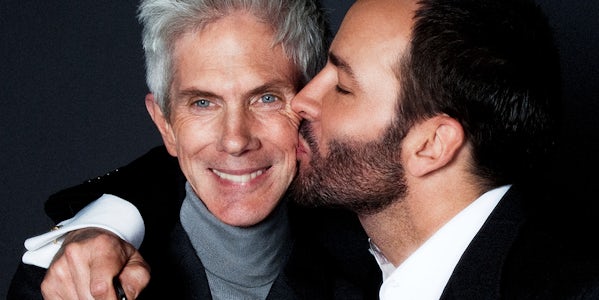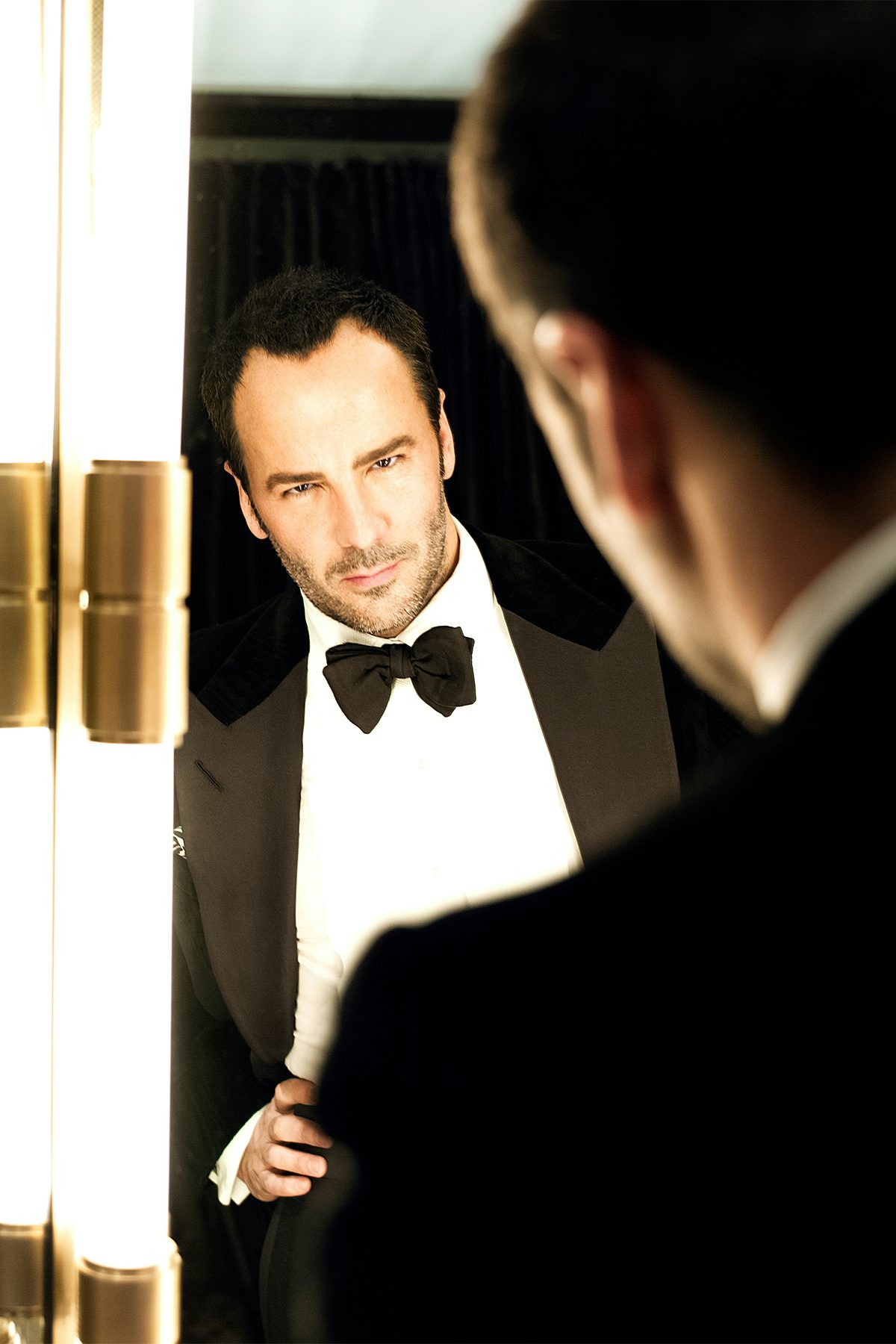Tom Ford: ‘I Believe in Fashion, Absolutely’ | Tim’s Take, Opinion
Tom Ford turned 60 at the end of August. If it was less so for him, the birthday was surely some kind of watershed for popular culture. The man whose libertine sensibility helped shape a quarter of a century of style was now easing into his seventh decade. That was enough to make anyone stop and wonder where time goes.
Fortunately, there’s a new book to clarify how, where and why. Tom Ford 002 is the lavish companion volume to the door-stopper that appeared in 2004, soon after Ford traumatically parted ways with Gucci. The new instalment marks a decade and a half of exhilarating, challenging changes for Ford: professionally, with the global growth of his own brand and his move into film-making (both “A Single Man” and “Nocturnal Animals” were Oscar-nominated). And personally: leaving London for Los Angeles, and having a son, Jack, now 9. But most shattering of all: three weeks after his birthday, Ford’s partner of 35 years, the fashion editor Richard Buckley, passed away.
A month on, the designer rings from his home in LA. I have interviewed him so often over the years he could be my “Mastermind” subject, however it’s been a while and, considering the circumstances, I’m surprised he decided to go ahead with the call at all. But there was always that — Tom the consummate professional, even during his tumultuous, substance-plagued 40s. So here he is, voice still the same laconic drawl, except when he laughs. His laugh was always special, like a release. Even while everything has changed, some things just don’t.
Tim Blanks: When you were putting the book together, what struck you most when you reflected back?
Tom Ford: One of the things that I talk about is that you get to give the world your taste once. And it’s true, I think there’s a common thread to all of my work because, of course, I’m the same person and I tend to like the same things. There’s a reflection of the times in that there’s certain things that I wouldn’t do today that I did then. But getting older, having a kid, it changes your perception of what you want to put out in the world. And in my case, it’s less overtly sexual but still sensual. On the other hand, I know that my thinking has had to evolve, though I do think it is holding back creativity in a lot of ways.
TB: You mean cancel culture?
TF: You really have to think and rethink everything you do. ‘Oh my God, will it offend anyone, is this going to be misinterpreted?’ As a designer, of course we always appropriated things from a lot of different cultures, but it was seen as a form of celebration and honouring that particular culture. I would think, ‘Oh, this is beautiful, I want to put this out in the world.’ And now you have to think twice because it can be called out as appropriation. If it’s not your own culture, you’re not really allowed to pull from it. Yves Saint Laurent would never have been able to do a Chinese collection, a peasant collection. How would he ever have been able to do a peasant collection in today’s world? There are so many things that could never have been created, but at the same time, this shift needed to happen.
There is a zero-tolerance policy, which is great in many ways but very difficult to manage if you are a public person or if you are running a company. You have to think about all of it. The good thing is that people are now able to show the world and be proud of who they are. I believe you should be whatever you want to be. If I am casting a transgender role in a movie I have a lot of great transgender actors to choose from. If I am casting a gay character I have a lot of gay actors to choose from. But it’s gotten tough to be creative. Actually it has gotten very hard to be spontaneous, I think, in today’s world because you have to rethink yourself. You can’t just let yourself go. You’re starting out trying to design or trying to write or whatever with a kind of framework around yourself. I do feel it hinders the ability to just be loose. What I usually try to do is be loose, analyse it and say, ‘Alright, what should I rein in, what should I not rein in? Is this right, is this wrong?’
TB: Are you finding that with film and with fashion?
TF: Oh God, yes. Absolutely! I mean, I haven’t made a movie yet [since the start of the pandemic]. With Covid, I thought I was going to be very creative. Well, actually I didn’t think that. I started off Covid like everyone. I had to furlough an enormous number of employees and we had to close stores temporarily. My father died right at the beginning of Covid — not from Covid — and I cried but not in the way that I cried when I had to get on the phone and make the announcement that we were going to have to furlough employees. That was one of the most emotional things, up until Richard died, that I had gone through. It just made me realise how emotionally attached I am to everyone who works with me, and to the company and to what I do.
TB: You once told me you would love to devote yourself to film-making but didn’t because ‘there are too many people who depend on me with what I do in fashion.’
TF: There are a lot of people who depend on me and that’s what I suppose I really felt. However, when we had all that space, I have a book that I’ve been needing to adapt and I kept thinking every day, ‘Okay, I’m gonna start that,’ but I didn’t feel remotely creative. I felt very disturbed by things going on politically, of course, and just dealing with it every day, I did not feel creative, I felt shell-shocked. Which I think a lot of people did.
A portrait of the American designer Tom Ford featured in Tom Ford 002. Alexei Hay.
TB: Did you feel your work should reflect, absorb and express that whole experience?
TF: I wasn’t able to produce. My factories were closed in Milan, my atelier was closed. There was one collection, it was put together with spit and glue basically. It wasn’t going to the stores because stores were closed. But collections since then have reflected it, certainly the last one I put on a runway. It was joyful, it was ‘let’s move on, let’s get back to beauty and energy and to having fun.’ It’s reflected now — or it was in that collection — in terms of optimism for the future.
TB: Do you think the pandemic has reaffirmed your faith in fashion?
TF: I don’t think my faith in fashion ever wavered. As I said, I was maybe not feeling terribly creative. When you’re staying at home, you’re not going anywhere, not seeing anything and not being inspired by the outside world, other than through the television, I think it’s hard. But I believe in fashion, absolutely.
TB: One difference between the 2004 and 2021 books is that I feel you in the earlier one, and in this new one I sense you directing alter egos, male and female, like models Jon Kortajarena and Mica Argañaraz. Is that down to the passage of time?
TF: As you get older, you can always find a more beautiful version of yourself [laughs]. At a certain point, let’s look at what I wish I was at 25 or 30 or 35 rather than what I actually am at 60.
TB: How was turning 60?
TF: Forty was the most traumatic change for me and it threw me into a depression that lasted eight or nine years. By 40 I’d already been very successful and had plenty of money and lots of houses. I’d achieved all these things that I thought I always wanted and then you think, ‘Okay, is this it?’ And so 40 threw me into a drug and alcohol problem that I was able to get over by the end of my 40s. It was really tough, 40. Fifty was not tough at all. Of course, with these chapters, you realise, ‘I’m probably moving into Act Three.’ And you look back and you think, ‘What do I want to continue doing? What do I not want to continue doing? Where’s my life? What have I done?’ And so in that way, putting this book together was great because it kind of tied that up in a nice little box and slipcovered it, and now I can move on to the next chapter.
TB: In the book, you consider the notion of Tom Ford continuing as a brand after you’re gone. How do you imagine it evolving?
TF: I don’t think you can imagine. For me, it’s sensuality and clothes that accentuate your body. Everyone always says, ‘Oh, he’s a sexy designer, he’s a sexy designer.’ You know, I don’t try to be ‘the sexy designer,’ I just start to make something and I like the human body and I think, ‘Okay, everyone always wants their waist to look like this and their shoulders to look like that,’ and you know I design intuitively and then ultimately what it is, everyone else usually calls it sexy. But you never know when you die, what can happen to your company. I mean, do you think Hubert de Givenchy would have contemplated ‘Givenchy’? You have no control of that any more, you’re dead. Tom Ford dog food in the supermarket? I have no idea what anyone would do with my name.
TB: There’s perhaps a note of elegy in the book when you say fashion is a way of not feeling mortal.
TF: Oh, that’s true, absolutely. I think our entire culture is built around trying to make all of us feel that we’re not going to die. Death in our culture is almost embarrassing. It’s something we want to quickly get away from and move on. I think it scares everyone. And buying new things is a way of constantly renovating yourself. As old as you get, you can put on a beautiful new pair of shoes. A woman can have her nails lacquered, put on a beautiful piece of jewellery, and when you stare down at your hand, it’s beautiful. When you look down, your shoes are shiny and perfect and new. It’s a way of feeling… ‘immortal’ isn’t the right word… it’s a way of denying mortality by constantly being able to refresh yourself through that. But our culture wants to pretend that death doesn’t exist.
TB: Your son’s generation has a completely different way of looking at things. How does that make you feel?
TF: It’s something that’s happened with every generation. You go back and you read something from the 18th century and the people in their 60s are talking about how they don’t understand youth, or you go back to The Beatles, and the older generation’s reaction. This is a normal thing. But I do think this transformation is completely different because it is a transformation of the mind. Jack doesn’t do social media obviously at his age — I dread the day when that starts — but he’s quite comfortable in a virtual reality, and then I have to force him to get off and go swimming or play tennis or run around and live in the ‘real’ world, as we call it. But what’s to say that isn’t going to be his real world? Do I hold him back, or do I let him become part of his time? And his time, whatever he’s going to create, whatever his generation’s contribution is to history, to the development of the human race, is starting from the base of where they are now as kids, even though it’s not our time. I do think that there’s going to be a line drawn that will relate to technology. It’s different than listening to different music or wearing different clothes. This is a complete change in brain development, and an acceptance of a virtual reality which has maybe become The Reality. Reality created in his mind and the mind of other kids playing Minecraft. I think everyone over 40 or 45, whatever the cut-off was — yes, we can use social media, yes, we can technically do all these things, but my brain is wired very differently than his.
TB: What do you think your life and your work will ultimately say to future generations?
TF: I was part of my time. I mean part of my time with clothing. So maybe I’m backtracking on what I just said about the virtual world being the real world. We are still material beings and material beings in the future will still need to eat, the food will still need to taste great and they’ll still need to put on clothes, I hope, and those clothes will still need to fit. Even in the virtual world, we have touch, when we get off our devices. Maybe the reality is that I don’t know. People always try to analyse what the world is gonna think of them later. I hate that word, ‘legacy.’ Nobody knows what the hell their legacy is gonna be. Only time will tell.
This article first appeared in the November 11, 2021 issue of ES Magazine.
Editor’s Note: This article was revised on 15th November 2021. An earlier version of this article misstated the number of years Tom Ford and his partner Richard Buckley were together.
Related Articles:
The Business of Being Tom Ford
Tim Blanks’ Top Fashion Shows of All-Time: Tom Ford’s Yves Saint Laurent Finale, March 7, 2004






